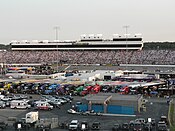Richmond International Raceway
| (America's Premier Short Track) | |
|---|---|
 
Richmond International Raceway as seen from the stands.
|
|
| Location | Henrico County, Virginia, United States |
| Time zone | UTC−5 / −4 (DST) |
| Coordinates | 37°35′30″N 77°25′15″W / 37.59169°N 77.42091°WCoordinates: 37°35′30″N 77°25′15″W / 37.59169°N 77.42091°W |
| Capacity | 71,000 |
| Owner | International Speedway Corporation |
| Operator | International Speedway Corporation |
| Opened | 1946 |
| Former names | Richmond Fairgrounds Raceway 1969–1988 Virginia State Fairgrounds 1964–1968 Atlantic Rural Fairgrounds 1955–1963 Atlantic Rural Exposition Fairgrounds 1946–1955 |
| Major events |
Monster Energy NASCAR Cup Series Toyota Owners 400 Federated Auto Parts 400 NASCAR Xfinity Series ToyotaCare 250 (spring race) Virginia 529 College Savings 250 (fall race) |
| D-shaped oval (1988-present) | |
| Surface | Asphalt |
| Length | 0.75 mi (1.21 km) |
| Turns | 4 |
| Banking | 14° in turns 8° on frontstretch 2° on backstretch |
| Lap record | 0:15.3197 seconds (176.244 mph) (Sam Hornish Jr., Team Penske, 2005, IndyCar) |
| Website | www |
Richmond International Raceway (RIR) is a 0.75 miles (1.21 km), D-shaped, asphalt race track located just outside Richmond, Virginia in Henrico County. It hosts the Monster Energy NASCAR Cup Series and NASCAR Xfinity Series. Known as "America's premier short track", it formerly hosted a NASCAR Camping World Truck Series race, an IndyCar Series race, and two USAC sprint car races.
Until 2016, Richmond International Raceway was one of several race tracks to host all of its events at night. The track sold out 33 consecutive NASCAR Cup Series races. The sellout streak ended in September 2008 partially due to the economic downturn, though the major factor in ticket sales was the impact of Tropical Storm Hanna.
Richmond has hosted the final "regular-season" race, leading up to the start of the NASCAR Cup Series Chase for the Championship, each year since the concept was introduced in 2004.
In 2010, Richmond International Raceway introduced a state-of-the-art video scoring tower that boasts more LED square footage than any other in the motorsports industry. The cap features four high definition LED screens that measure 38-feet wide by 24-feet high. The screens broadcast live race action and pre-produced video and graphics. The stem shows running order and has the ability to rotate through the entire field.
Racing sports has a long tradition in Virginia, dating back to colonial English times. From 1898 to World War I, the Deep Run Hunt Club the Northside area of Ginter Park was the site of the club's somewhat annual steeplechase race. After a decade hiatus, the annual races were moved to Curles Neck in 1928 on the south side of Richmond.
Shortly after the attack on Pearl Harbor, all auto racing was suspended due to WWII. From 1942 to 1945 no events were contested, banned by the U.S. government primarily on account of rationing.
...
Wikipedia
